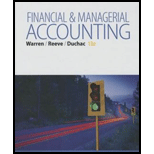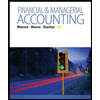
1.
Bonds Payable: Bonds payable are referred to long-term debts of the business, issued to various lenders known as bondholders, generally in multiples of $1,000 per bond, to raise fund for financing the operations.
Discount on bonds payable: It occurs when the bonds are issued at a low price than the face value.
Installment note: It is a debt in which the borrower is required to pay equal periodic payments to the lender based on the term of the note.
To Journalize: The entries to record the transactions.
1.
Explanation of Solution
| Date | Accounts and Explanation | Post Ref. | Debit ($) |
Credit ($) |
| 2016 | Cash | 62,817,040 | ||
| July 1 | Premium on Bonds Payable (1) | 7,817,40 | ||
| Bonds Payable | 55,000,000 | |||
| (To record issue of bonds at premium) | ||||
| October 1 | Cash | 450,000 | ||
| Notes Payable | 450,000 | |||
| (To record issue of 6% notes for cash) | ||||
| December 31 | Interest Expense | 9,000 | ||
| Interest Payable | 9,000 | |||
| (To record interest accrued on installment note) | ||||
| December 31 | Interest Expense (4) | 2,084,148 | ||
| Premium on Bonds Payable (2) | 390,852 | |||
| Cash (3) | 2,475,000 | |||
| (To record semiannual interest payment and amortization on bonds) |
Table (1)
| Date | Accounts and Explanation | Post Ref. | Debit ($) |
Credit ($) |
| 2017 | Interest Expense (4) | 2,084,148 | ||
| June 30 | Premium on Bonds Payable (2) | 390,852 | ||
| Cash (3) | 2,475,000 | |||
| (To record semiannual interest payment and amortization on bonds) | ||||
| September 30 | Interest Expense | 27,000 | ||
| Interest Payable | 9,000 | |||
| Notes Payable | 61,342 | |||
| Cash | 97,342 | |||
| (To record the annual payment on note) | ||||
| December 31 | Interest Expense | 7,773 | ||
| Interest Payable | 7,773 | |||
| To record interest accrued on installment note) | ||||
| December 31 | Interest Expense (4) | 2,084,148 | ||
| Premium on Bonds Payable (2) | 390,852 | |||
| Cash (3) | 2,475,000 | |||
| (To record semiannual interest payment and amortization on bonds) |
Table (2)
| Date | Accounts and Explanation | Post Ref. | Debit ($) |
Credit ($) |
| 2018 | Bonds Payable | 55,000,000 | ||
| June 30 | Premium on Bonds Payable | 6,253,632 | ||
| Gain on Redemption of Bonds (6) | 4,603,632 | |||
| Cash (5) | 56,650,000 | |||
| (To record redemption of bonds) | ||||
| September 30 | Interest Expense | 23,320 | ||
| Interest Payable | 7,773 | |||
| Notes Payable | 66,249 | |||
| Cash | 97,342 | |||
| (To record the annual payment on note) |
Table (3)
Working notes:
Calculate discount on bonds payable.
Calculate premium on bonds payable semiannually.
Calculate the amount of cash interest.
Calculate the interest expense on the bond.
Calculate cash paid to redeem the bonds.
Compute gain on the redemption of the bonds payable.
2016:
- On July 1, Cash is debited as it increased the asset. Premium on bonds payable is credited as it increased the liability. Bonds payable is credited as it increased the liability.
- On October 1, Cash is debited as it increased the asset. Notes payable is credited as it increased the liability.
- On December 31, interest expense is debited as it decreases the equity value. Interest payable is credited as it increased the liability.
- On December 31, interest expense is debited as it decreases the equity value. Premium on bonds payable is debited as it decreased the liability. Cash is credited as it decreased the asset.
2017:
- On June 30, interest expense is debited as it decreases the equity value. Premium on bonds payable is debited as it decreased the liability. Cash is credited as it decreased the asset.
- On September 30, interest expense is debited as it decreases the equity value. Interest payable and notes payable are debited as it decreased the liability. Cash is credited as it decreased the asset.
- On December 31, interest expense is debited as it decreases the equity value. Interest payable is credited as it increased the liability.
- On December 31, interest expense is debited as it decreases the equity value. Premium on bonds payable is debited as it decreased the liability. Cash is credited as it decreased the asset.
2018:
- On June 30, Bonds payable is debited as it decreased liability. Premium on bonds payable is debited as it decreased the liability. Gain on redemption of bonds is credited as it increases the equity value. Cash is credited as it decreased the asset.
- On September 30, interest expense is debited as it decreases the equity value. Interest payable and notes payable are debited as it decreased the liability. Cash is credited as it decreased the asset.
2.
a.
The amount of interest expense in 2016.
2.
a.
Explanation of Solution
Determine the amount of interest expense in 2016.
b.
The amount of interest expense in 2017.
b.
Explanation of Solution
Determine the amount of interest expense in 2017.
3.
The carrying amount of bonds as of December 31, 2017.
3.
Explanation of Solution
Determine the carrying amount of bonds as of December 31, 2017.
| Particulars | Amount ($) |
| Initial carrying amount of bonds | 62,817,040 |
| Premium amortized on December 31, 2016 | (390,852) |
| Premium amortized on June 30, 2017 | (390,852) |
| Premium amortized on December 31, 2017 | (390,852) |
| Carrying amount of bonds, December 31, 2017 | 61,644,484 |
Table (4)
Want to see more full solutions like this?
Chapter 12 Solutions
Bundle: Financial & Managerial Accounting, 13th + CengageNOWv2, 2 terms (12 months) Printed Access Card
- What are two double entries the following transaction? Account Receivable. Account payable. Rent Expenses. Cell phone bill, cable, light bill, gas, and monthly income of $4,000.00 what will be your net income after all expenses are paid. Please figure out your own price for each expense.arrow_forwardCan you solve this general accounting problem using appropriate accounting principles?arrow_forwardCan you help me solve this general accounting question using the correct accounting procedures?arrow_forward
- I need the correct answer to this general accounting problem using the standard accounting approach.arrow_forwardI need help solving this general accounting question with the proper methodology.arrow_forwardI need the correct answer to this general accounting problem using the standard accounting approach.arrow_forward
- Can you solve this general accounting question with the appropriate accounting analysis techniques?arrow_forwardPlease explain the solution to this general accounting problem with accurate principles.arrow_forwardPlease explain the solution to this general accounting problem with accurate principles.arrow_forward
 Financial Accounting: The Impact on Decision Make...AccountingISBN:9781305654174Author:Gary A. Porter, Curtis L. NortonPublisher:Cengage Learning
Financial Accounting: The Impact on Decision Make...AccountingISBN:9781305654174Author:Gary A. Porter, Curtis L. NortonPublisher:Cengage Learning Financial AccountingAccountingISBN:9781305088436Author:Carl Warren, Jim Reeve, Jonathan DuchacPublisher:Cengage LearningPrinciples of Accounting Volume 1AccountingISBN:9781947172685Author:OpenStaxPublisher:OpenStax College
Financial AccountingAccountingISBN:9781305088436Author:Carl Warren, Jim Reeve, Jonathan DuchacPublisher:Cengage LearningPrinciples of Accounting Volume 1AccountingISBN:9781947172685Author:OpenStaxPublisher:OpenStax College Financial & Managerial AccountingAccountingISBN:9781285866307Author:Carl Warren, James M. Reeve, Jonathan DuchacPublisher:Cengage Learning
Financial & Managerial AccountingAccountingISBN:9781285866307Author:Carl Warren, James M. Reeve, Jonathan DuchacPublisher:Cengage Learning College Accounting, Chapters 1-27AccountingISBN:9781337794756Author:HEINTZ, James A.Publisher:Cengage Learning,
College Accounting, Chapters 1-27AccountingISBN:9781337794756Author:HEINTZ, James A.Publisher:Cengage Learning, Cornerstones of Financial AccountingAccountingISBN:9781337690881Author:Jay Rich, Jeff JonesPublisher:Cengage Learning
Cornerstones of Financial AccountingAccountingISBN:9781337690881Author:Jay Rich, Jeff JonesPublisher:Cengage Learning





